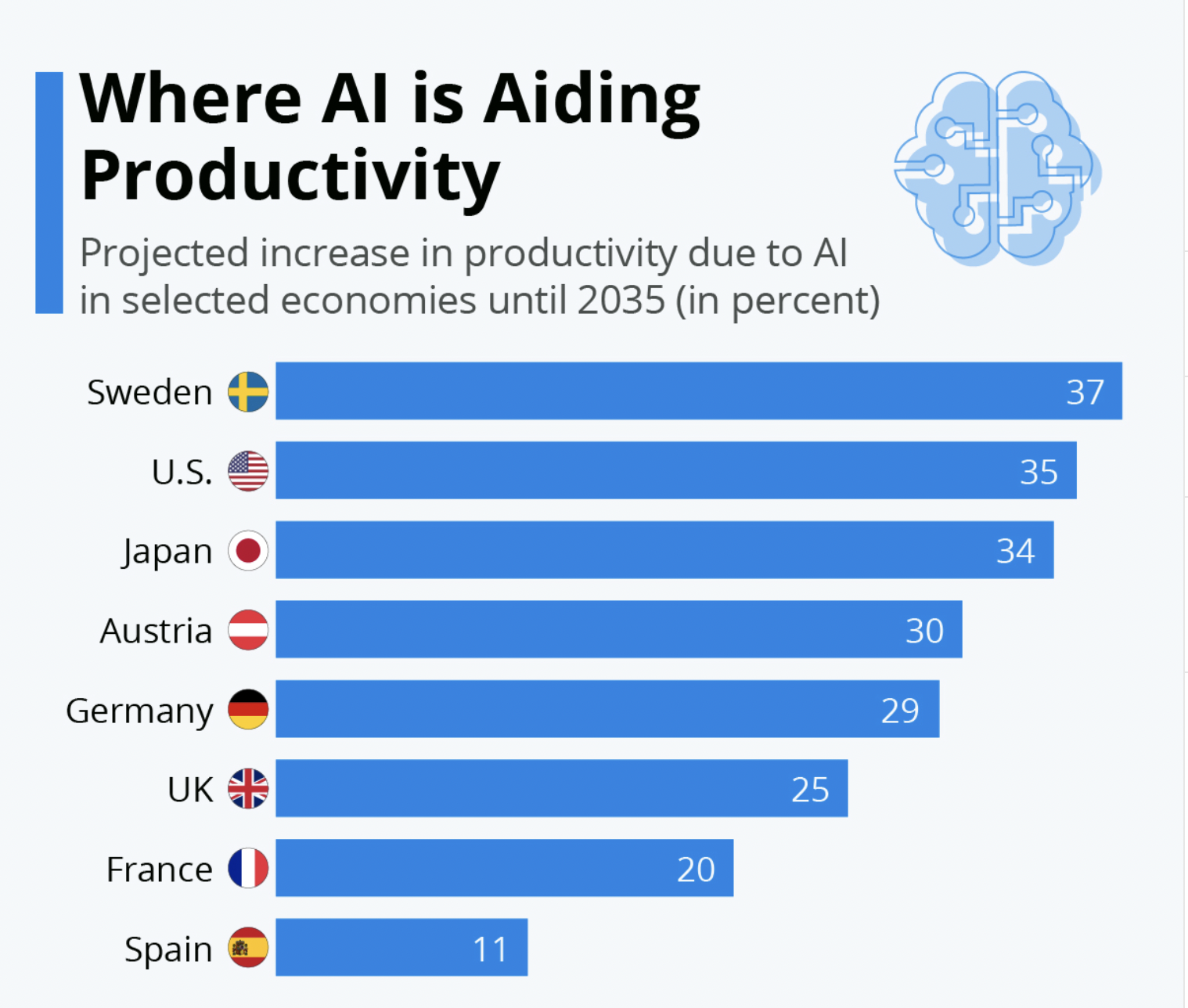The current work climate has meant that, more than ever, the reliance on technology is even more prominent. The pandemic has become a catalyst for more machine style learning and artificial intelligence. Both machine learning and artificial intelligence are strongly linked to each other and are sometimes used interchangeably, but they are different concepts of computer science that serve us in different ways. Because of the adaptability of Artificial Intelligence and Machine Learning, it is becoming more and more integrated into our everyday hardware.

(Image Source: Statista)
What is Artificial Intelligence?
Artificial Intelligence is a sector of computer science that can mimic human intelligence. It is primary to technology that aims to simulate human functions and intelligent systems. Artificial Intelligence is not necessarily preprogrammed, and instead, functions algorithms and deep learning neural networks. Deep learning neural networks is essentially a type of network that layers input and output in order for artificial intelligence to function as we know it to. Neural networks mimic the human brain through a set of algorithms. Examples of day-to-day artificial intelligence are Siri, AlphaGo and Alexa.
Artificial Intelligence can generally be categorised into three different types, weak artificial intelligence, general artificial intelligence and strong artificial intelligence.
Weak artificial intelligence is also referred to as narrow artificial intelligence and is a type of artificial intelligence that is linked to a specific or narrow area. This means that this type of artificial intelligence simulates human cognition. For example, the quick analysis of data that perhaps humans alone would not be able to process in such an efficient manner. Weak artificial intelligence lacks the consciousness that a human has, however can simulate it at times to suit our needs. This category of artificial intelligence can turn a big set of data into usable information and does this by detecting patterns and making predictions from assessing these patterns. For example, email spam filters are a very simple artificial intelligence that is widely used and is often used to solve a specific yet simple problem.
General artificial intelligence is based on the hypothetical potential of artificial intelligence. It is essentially an agent that can learn and acquire the knowledge to output any task that a human being can. This can be in reference to both strong and weak artificial intelligence. It is used with machine translation in which a machine needs to be able to read many different languages and translate, but also understand the context of a sentence.
Strong artificial intelligence is the type of artificial intelligence that would match the ability of humans. This would include consciousness, and the ability to solve problems and plan for the future. Over time, this type of intelligence would learn more about human intelligence because of the growing number of inputs it would receive. Although strong artificial intelligence is still in the research and development stage, many have expressed their optimistic opinions about it even though it is still very much a theoretical concept at this stage in time. The Turing test is still a test used to evaluate the intelligence of an artificial intelligence system. The Turing test refers to a test founded by Alan Turing, which tests the ability of the behaviour of a machine and how close it runs parallel to the intelligence of human beings, it includes the appearance of consciousness.
What is Machine Learning?
Machine learning is slightly different to artificial intelligence in the sense that it is about extracting knowledge from data rather than it patterning as artificial intelligence does. Machine learning is able to process an excessive amount of data and establish decisions about it based on past inputs, however, unlike artificial intelligence, it does not need to be explicitly programmed.
In a nutshell, machine learning is a machine that uses an extortionate amount of structured data so that a machine can generate an accurate or desired result. For example, with a search engine, by entering a search for basketball players, machine learning will organise an already structured set of data and generate results for basketball players.
There are three types of machine learning:
- Supervised learning
- Reinforcement learning
- Unsupervised learning
What is supervised learning?
This type of machine learning uses a training set as a blueprint for machines and models to yield the desired output. The model will learn over time about the patterns that are inputted into the machine. The algorithm that is used when it comes to machine learning measures accuracy through loss function and continues to adjust until any errors are ironed out or minimised. Supervised learning can be categorised into two types of problems when it comes to data.
Classification is the first type and regression is the other. Classification uses an algorithm to assign test data in an accurate fashion into specific categories. Classification, when it comes to machine learning recognises specific entities and data sets and then attempts to draw some conclusions on how those entities should be defined, categorised and labelled. Common algorithms are linear classifiers, support vector machines and decision trees.
Regression is used to evaluate and understand the relationship between dependent and independent variables. Regression is commonly used to make projections, such as sales revenue for a business or company. Just like classification, there are linear regressions and logistical regressions that are popular algorithms.
Linear regressions are used specifically to identify the relationship between a dependent variable and one or more independent variables, and essentially makes predictions about future outcomes. When there is simply one independent variable and one dependent variable, it is simply known as simple linear regression. Using a graph, patterns can be outlined and recognised.
What is reinforcement learning?
Another type of machine learning is reinforcement learning and is when learning models make a sequence of decisions. Reinforcement learning is centralised and focused around trial and error as a way to come up with a solution for a problem. In order to get the machine to do what the programmer needs and wants it to do, there are both artificial rewards and penalties for the actions that are performed. This type of reinforcement is used within machine learning as a way to cement the overall goal of machine learning. A reward policy is set and a model can operate in a way to maximise that reward. For example, with autonomous driving and self-driving cars, factors to consider would be complying with the speed limits and being rewarded for upholding this requirement. That would be aligned with the safety of the passengers in a standard car for road use. That type of algorithm could even be used to automate a lot of requirements for future employment and streamline the processes within the workplace.
The challenges come with reinforcement learning in the simulation environment. For example with online games, such as chess or Atari Games – the environment of a reward policy is more clear cut and simple than the systems that are used for things like autonomous driving. The trial and error expectations of this type of software and using reinforcement learning in this way is an extremely timely and vigorous process and still needs the test period in the real world to navigate an array of situations.
What is unsupervised learning?
Unsupervised learning when it comes to machine learning is the use of machine learning algorithms to analyse and cluster unlabeled data sets. The algorithms find hidden patterns and data groupings without the need for a human user or human intervention. It holds similarities to supervised learning in the sense that it still has the ability to discover differences and similarities in the inputted data, however, is unsupervised learning. This can also be referred to as predictive learning, as it observes the patterns of how the programmes have been used in the past. Take the example of a search engine, if you mistype a word, it will offer a correction based on past searches.
There is a range of unsupervised learning, which includes Hierarchical Clustering, Exclusive and Overlapping Clustering and Probabilistic Clustering.
Hierarchical Clustering can also be referred to as hierarchical cluster analysis. This essentially means that a cluster or clustering are initially grouped as isolated data sets. These data sets contain information that holds similarities which are then grouped together based on the similarities of those isolated data sets. Methods such as average linkage (This method is the mean distance between two points in each cluster) and complete linkage (this method is the maximum distance between two points in each cluster) are used to assess similarities in a data set.
Exclusive and Overlapping Clustering is a form of grouping a data set that can only exist in one cluster. With only one cluster, the way of organising a data set in this way is called exclusive clustering, but when there are multiple degrees of membership it is referred to as overlapping clustering. For example, if a data set is one cluster, but different features of the information make it part of other exclusive clusters, this is overlapping. Think of it like a ven diagram.
Probabilistic Clustering is a form of unsupervised learning that helps to solve soft clustering problems. This is when there are two distinct data sets that overlap and have very subtle similarities and differences. The Gaussian Mixture Model is the main mixture model that classifies data and is mostly used in probabilistic clustering.

(Image Source: IBM)
What is the difference between artificial intelligence and machine learning?
The key difference between both artificial intelligence and machine learning is that artificial intelligence is a technology that can enable a machine or software to simulate human behaviour while machine learning is a subset of artificial intelligence that is reliant on machines that automatically program and reprogram based on patterned data inputs. The way that they both operate and serve the needs of a user is different.
Aside from artificial intelligence simulating human behaviour and machine learning reflecting and patterning data, the key goals of using both differ. The goal of artificial intelligence is to make a smart computer system and hardware to solve complex problems as humans do. For example, with manufacturing robots and smart assistants like Siri, they can respond in the likeness of a human being. On the other hand, with machine learning, the goal is to allow machines to learn from inputted data sets and ensure desired outputs. This includes things like image recognition and predictive analytics.
Another difference between artificial intelligence and machine learning is based on intelligence systems used with artificial intelligence. They are designed to mimic human intelligence. Although there is still development happening in the way of consciousness, machine learning is taught to work with data to output a particular result.
Machine learning is technically a subset of artificial intelligence and a primary one at that. The range that artificial intelligence offers us is a lot more than machine learning. The scope of machine learning is limited. A key reason why machine learning is limited in that the algorithms used are trained to output a certain result which requires meticulous and consistent state input in the first place. This, in turn, makes it a tedious process as all the data has to be labelled in order to be categorised into one of the methods outlined previously. For example, the data and instructions given to a search engine (to pull out a specific requirement of data) are much more limited to instructions than digital voice assistants that respond in a human-like manner.
Some of the main applications of artificial intelligence are in the form of robots. Of course, robots don’t have a mind of their own, but they are able to complete a finite set of actions and tasks (because they were programmed to do so). The use of robots is an example of weak or narrow artificial intelligence and is experienced by many users on a day-to-day basis.
As a recap, weak artificial intelligence allows machines and software to act and make decisions based on programming, not data input. In contrast, the main applications of machine learning are based on actioning a request based on data entries. For example with Facebook tagging, specific names are chosen from a set of names associated with an account.
When it comes to being close to human decision making, artificial intelligence is designed to do just that. Artificial intelligence includes learning reasoning and predictive actions. Unsupervised learning leads to self-correction that is made by artificial intelligence. This is again in contrast to machine learning, that only self corrects when new data is introduced. An example of this is speech recognition and translating speech into text. The speech is segmented by frequency and then is able to convert the frequencies into words based on the data that has been inputted into the system.
When working with artificial intelligence, the skills required are different based on the needs of the way that it operates. Understanding algorithms, robotics, program design and data mining are key as this is what artificial intelligence is based around. Artificial Intelligence operates around algorithms to simulate human decision-making styles. Machine learning, on the other hand, requires a slightly different set of skills. These skills include applied mathematics, physics, programming languages, probability and statistics. These skills align with machine learning as it produces data results based on what is desired as an outcome with machine learning. Knowing that data entry is what is key to machine learning means that the skill set will also be focused around this.
The myths surrounding artificial intelligence and machine learning
Just as with any new technology, the human likeness of artificial intelligence has been the source of many generated myths.
A primary myth when it comes to artificial intelligence is that AI will one day turn conscious and potentially evil. A more realistic problem will most likely be that the goals of artificial intelligence will become misaligned with ours, and that will be based on what the algorithms have learnt and processed – not because it has a mind and consciousness of its own.
Aligned with the myth about artificial intelligence becoming sentient, a concern that a lot of people have is robots and how they might become problematic. This is a myth because robot hardware would not be the concern but perhaps misaligned intelligence as it only requires an internet connection. The misaligned intelligence could be an error in the code used or even just incorrect predictions based on past actions.
Another myth is that machines can’t have particular goals, however, with correct programming, most certainly can. There is lots of misinformation about artificial intelligence and machine learning, and myths that are generated because of it but understanding that the use of artificial intelligence is based around algorithms that are written by humans is key to knowing that many of these myths are not possible concerns at this time.
The future of artificial intelligence
The use of artificial intelligence is something that is very much at the forefront of technology and the future of it is still very much is in development and could present many futuristic possibilities.
Experts have posited that the rise of artificial intelligence will make the majority of users and people much better off.

(Image Source: Coding Dojo)
Living a more digital life comes with ease in the access of information. There are ranging possibilities within the realm of artificial intelligence that can amplify the effectiveness of human actions. Strong AI is predicted to be able to mimic and potentially even match human intelligence. This could be outlined by complex decision making, reasoning and learning. There is an element of this that already exists with the current elements that are on offer when it comes to artificial intelligence. With smart systems in place to assist with operating cars and even identifying certain diagnoses within healthcare, what’s to say that artificial intelligence doesn’t develop one step further and mimic human consciousness?
Indeed, there are concerns that are in play when it comes to the development and the future of artificial intelligence – one of these is data breaches. If artificial intelligence enters a further realm of human action, there might be abuse in data that could be used and exchanged for personal benefit. If this concern comes further to light with specific reference to artificial intelligence, then a value-based system could be implemented. A value-based system is a way to survey and apply surveillance to data complex systems and can ensure that any intelligent digital network (such as neural networks or anything that may present something that is more advanced) can be embedded with empathy within the algorithm to ensure that technology still operates alongside ethical expectations. Ensuring that the algorithms within artificial intelligence systems, that may harbour empathy, align with human intelligence in an accurate way is important and something that will be strongly considered in the future of this type of technology.
Artificial Intelligence and Machine Learning are concepts and technology that are very much becoming more and more integrated into our lives and are becoming more and more accommodating to the needs of its users. It’s exciting to see that artificial intelligence has shown the chance to develop into something that could reflect human intelligence in an aid-abiding way. That said, there are still concerns and ethical elements to consider. With experts still being in two minds about the predicted future of artificial intelligence, it will most certainly be a technological advancement to keep an eye out for.








